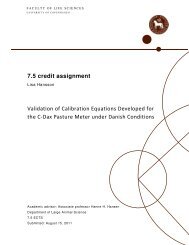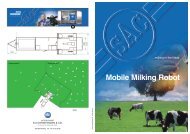Innovative Technology and Sustainable Development of Organic - 1.
Innovative Technology and Sustainable Development of Organic - 1.
Innovative Technology and Sustainable Development of Organic - 1.
Create successful ePaper yourself
Turn your PDF publications into a flip-book with our unique Google optimized e-Paper software.
countries, leading to four focus group interviews; two with organic dairy farmers, <strong>and</strong> two with<br />
advisors working in this sector. From the experiences <strong>of</strong> other group interviews with the objective <strong>of</strong><br />
generating debate, a minimum <strong>of</strong> four people should participate in each group (Kvale, 1994). The aim<br />
<strong>of</strong> this research was to gather the range <strong>of</strong> perceptions <strong>and</strong> values. To secure a discussion based on<br />
experience <strong>and</strong> visions, some farmers working with AMS were selected. This resulted in the following<br />
group sizes: farmers in the Netherl<strong>and</strong>s – five, <strong>of</strong> which two had AMS; farmers in Denmark – six, <strong>of</strong><br />
which three had AMS; advisors in the Netherl<strong>and</strong>s – eight; advisors in Denmark – six. The advisors<br />
chosen had knowledge about production <strong>of</strong> roughages, animal nutrition, <strong>and</strong> farm economics, which is<br />
due to the holistic view inherent to organic farming. In the Netherl<strong>and</strong>s, most <strong>of</strong> the practicing organic<br />
advisors participated, <strong>and</strong>, therefore only one group session was arranged. Consequently, in Denmark<br />
also one session was arranged. All participants were between 30 <strong>and</strong> 60 years old. The participants in<br />
each group were personally recruited by telephone. They knew they were going to talk about the use<br />
<strong>of</strong> AMS on organic dairy farms, although information was kept to a minimum prior to the meetings.<br />
2.3.3 Procedure<br />
The four group interviews were held between September 2004 <strong>and</strong> March 2005. No major events that<br />
could influence the perception <strong>of</strong> the stakeholders took place during this period. It was clearly stated at<br />
the beginning <strong>of</strong> each session that the results <strong>and</strong> conclusions <strong>of</strong> the interviews would be published<br />
ensuring anonymity <strong>of</strong> the participants. The bilingual moderator explained the aim <strong>and</strong> procedure <strong>of</strong><br />
the meeting, after which the participants introduced themselves to each other. The participants were<br />
invited to react freely to each <strong>of</strong> the moderator’s questions <strong>and</strong> to each other’s answers, remarks, <strong>and</strong><br />
opinions. They were thus left free to interact <strong>and</strong> to react to everything that occurred during the<br />
session. During the focus group interview, the moderator (who was the same for all the sessions)<br />
introduced the topics. These topics were similar for the sessions in Denmark <strong>and</strong> the Netherl<strong>and</strong>s,<br />
making it possible to pinpoint possible differences in perception between countries. The sessions lasted<br />
between 90 <strong>and</strong> 120 minutes. The interviews were audio taped <strong>and</strong> notes were made by the moderator.<br />
After the interviews, all material was transcribed <strong>and</strong> then analyzed. The condensation/indexation<br />
technique was used to analyze the sessions (Halkier, 2002). This was done by coding <strong>and</strong> categorizing<br />
all transcripts. Statements <strong>and</strong> discussion topics were systemized <strong>and</strong> grouped under coded headlines<br />
or keywords, frequency <strong>of</strong> occurrence, <strong>and</strong> time period in which they were discussed. This resulted in<br />
a schematic presentation <strong>of</strong> the topics <strong>and</strong> statements discussed, <strong>and</strong> the frequency <strong>and</strong> length <strong>of</strong> the<br />
coded topics. These schemes were then used to represent the essence <strong>of</strong> the analysis, conceptualizing<br />
the results. The results are discussed, using the literature review, based on conventional dairy farms<br />
with AMS, as reference.<br />
2.3.4 Questions<br />
Questions were designed to investigate whether the sustainability issues identified by literature as<br />
being influenced by AMS use on organic dairy farms, matched the stakeholders’ perceptions. This<br />
resulted in a list <strong>of</strong> questions, which were preceded by so-called positioning questions (Halkier, 2002)<br />
giving information on the participants’ backgrounds <strong>and</strong> practice <strong>and</strong> putting the group members at ease.<br />
The questions were mostly open, so as to let the participants take initiatives in relation to addressing<br />
topics. Later in the sessions, information from the theoretical review was brought up by the moderator<br />
for comment. In focus group interviews, general attitudes are discussed <strong>and</strong> not individual performances.<br />
Specific issues, which were identified in the theoretical background, as milk yield, direct energy<br />
Thesis Frank W. Oudshoorn 25




